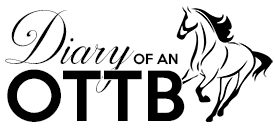Before Indy got off the trailer I spent the week prior reading just about every book I could on how to retrain an OTTB. I joined so many OTTB Facebook groups that my Newsfeed is now constantly filled with all things Thoroughbred. I was desperately trying to educate myself as quickly as I could trying to make up for the all the years of education and training experience I lacked.
Let’s be real, that didn’t work out perfectly.
Most of the books I read, including Beyond the Track, were useful but eventually they’ll all tell you something similar to this: Thoroughbreds are sensitive. They’ll eat a lot and you’ll need to supplement their feed with loads of forage. They have thin skin, short attention spans, and require a few weeks off from the track before starting training in a new discipline. Most don’t know how to lead or tie, so it’s something that should be trained. They don’t know how to carry themselves properly. They work best in a routine or program. And really the list continues.
This was all a lot of information that I kind of already knew, not to mention being equally applicable for a handful of non-TBs I know. One of the most helpful things I’ve found so far was watching Scott Purdum’s YouTube series on retraining an OTTB. He breaks sessions into 3o minute episodes and is pretty honest about how much time he’s spent working with the horse off camera, which I appreciate because it gives you some perspective as to the effort being put in. And he’s also great at teaching viewers what to look for with OTTBs and how to identify and correct problems that come up during the sessions. You can check out one of those sessions here.
While some books laid out a weekly schedule detailing how many weeks should be allowed for let down and adjustment, all the way to when you should start training and riding your OTTB.
I’ve got news for you: Training an OTTB starts on the first day, the minute they get off the trailer.
It’s up to you to make this a good experience for them. If you’re not a confident ground handler, take some lessons prior to your OTTB getting to you or while you’re giving your horse some time off to settle in. You’ll thank me for this. The best thing you can do is be prepared the worst and hope for the best. Chances are the reality will fall somewhere in between and if you’re a calm and confident leader for your OTTB, you’re already off to a great start. The last thing you want to do is start off a relationship getting dragged around by your new pal.
This first day together, I think, is pretty crucial. Consider it your first date. You only know the superficial things about your new friend and you can’t possibly gauge their reactions to certain situations. So don’t! Take their reactions at face value. Be patient and understanding.
And really, don’t follow a schedule. Let them tell you when they’re ready for work. My definition of that is acting like a good upstanding horse citizen – good weight, calm in his paddock, ready to be led. This is where you can start getting to know your new OTTB and start identifying things that should be worked on.
Day 1 of Indy produced some good information on things we needed to work on: yielding to pressure from the halter, learning how to tie, and how to deal with the horrifying product known as fly spray.
Call them problems, sticky spots, issues, whatever. It’s a horse… my horse. And it’s on me to address them, correct them, train them out. Observe, address, repeat. Have a conversation. Then you can get back to me about how that first date went.
3
